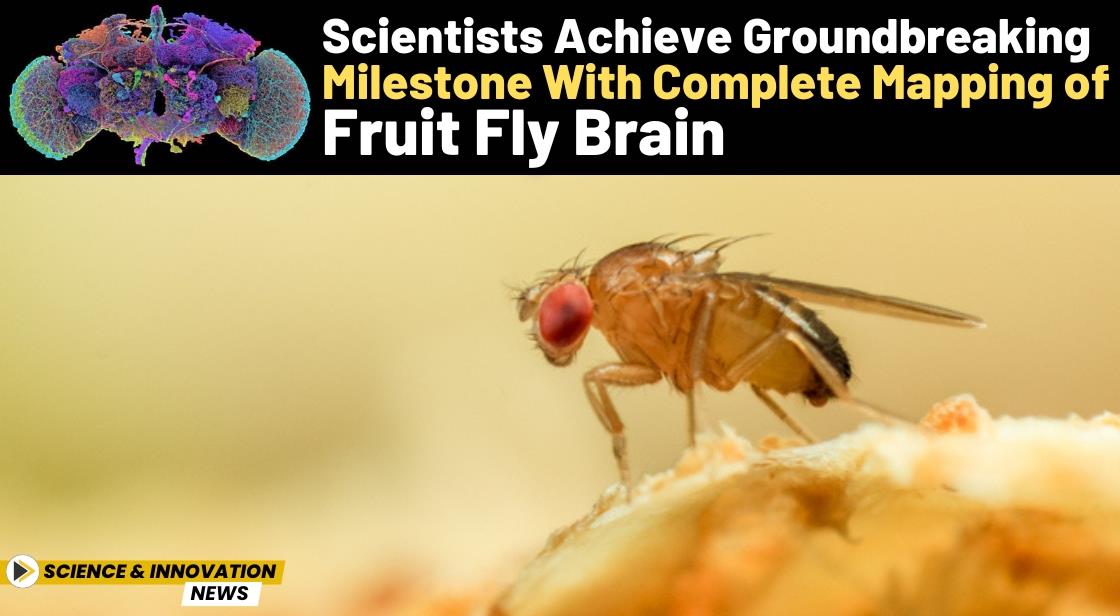Scientists Achieve Groundbreaking Milestone with Complete Mapping of Fruit Fly Brain

News Synopsis
In a significant leap for neurobiological research, scientists have successfully mapped the entire brain of an adult fruit fly. This achievement, announced on Thursday, could offer valuable insights into how brains function not only in insects but also across the animal kingdom, including humans.
The research has unveiled more than 50 million connections between over 139,000 neurons, or brain nerve cells, of the fruit fly species Drosophila melanogaster, a common model organism in neurobiology. This accomplishment may pave the way for further brain mapping in other species and enhance our understanding of how brains are wired and how these connections support healthy brain functions.
Fruit Fly Brain: Key to Unlocking Secrets of All Brains
"You might be asking why we should care about the brain of a fruit fly. My simple answer is that if we can truly understand how any brain functions, it’s bound to tell us something about all brains,” said Sebastian Seung, a professor of neuroscience and computer science at Princeton University, and one of the co-leaders of the research.
This work, which was detailed in several studies published in Nature, focuses on creating a full "connectome"—a detailed wiring diagram—of the adult fruit fly brain. While previous connectomes have been developed for simpler organisms such as the nematode worm Caenorhabditis elegans and the larval stage of the fruit fly, this new map represents a more advanced and complex version due to the adult fruit fly's sophisticated behaviors.
Unraveling Complex Behaviors in the Fruit Fly Brain
The adult fruit fly brain, less than 0.04 inches (1mm) in width, is responsible for behaviors such as walking, flying, memory, navigation, and social interactions. Despite its tiny size, the brain of this insect solves many of the same problems humans do.
"Flies are an important model system for neurosciences. Their brains solve many of the same problems we do... They’re capable of sophisticated behaviors like the execution of walking and flying, learning and memory behaviors, navigation, feeding and even social interactions,” explained Mala Murthy, a neuroscientist at Princeton and another co-leader of the research.
Among the studies, one focused on the circuits responsible for walking behavior and discovered how the flies stop walking, while another investigated the taste network and grooming circuits, such as how a fly uses its leg to clean its antennae.
Additionally, the visual system was studied, looking at how the fly processes motion and color through its eyes. One of the most interesting discoveries was the identification of "hub neurons"—large clusters of neurons that are believed to speed up information flow throughout the brain.
Mapping the Fruit Fly Brain: A Neurobiological Breakthrough
The detailed brain map crafted by the scientists not only tracked how the brain hemispheres and behavioral circuits are organized but also identified all of the cell types in the fly's brain. The researchers were able to pinpoint various neuron types and synaptic connections—the chemical signals that neurons use to communicate. Additionally, the study uncovered which chemicals are secreted by different neurons in the brain.
Gregory Jefferis, a neuroscientist at the University of Cambridge and co-leader of the research, expressed his admiration for the intricate structure of the fly brain: "It’s beautiful," he said, reflecting the aesthetic appreciation scientists can have for the biological structures they study.
This research was part of a global collaboration under the FlyWire Consortium, a large group of scientists working together to decode the complexities of the fruit fly brain.
Future Implications: Paving the Way for Advanced Brain Mapping
The fruit fly brain connectome is expected to be a stepping stone towards similar mapping projects in other species. Understanding the neural wiring in simpler organisms like the fruit fly could eventually provide essential knowledge for mapping and understanding the complexities of the human brain. As we continue to explore how brain circuits contribute to behavior, this research opens the door to potential breakthroughs in neuroscience, behavior studies, and even the treatment of neurological disorders.
Conclusion:
The complete mapping of the adult fruit fly brain represents a monumental advancement in neurobiological research. By uncovering the intricate wiring and millions of neural connections in this tiny insect, scientists have laid the groundwork for understanding brain functions across the animal kingdom, including humans.
This research is not only a testament to the importance of model organisms like Drosophila melanogaster in neuroscience but also a stepping stone towards more complex brain mapping projects in other species. As we continue to explore the neural circuits that drive behavior, the fruit fly brain connectome could unlock new avenues for studying brain functions, improving neurological health, and advancing our knowledge of cognition and behavior in both animals and humans.
You May Like









